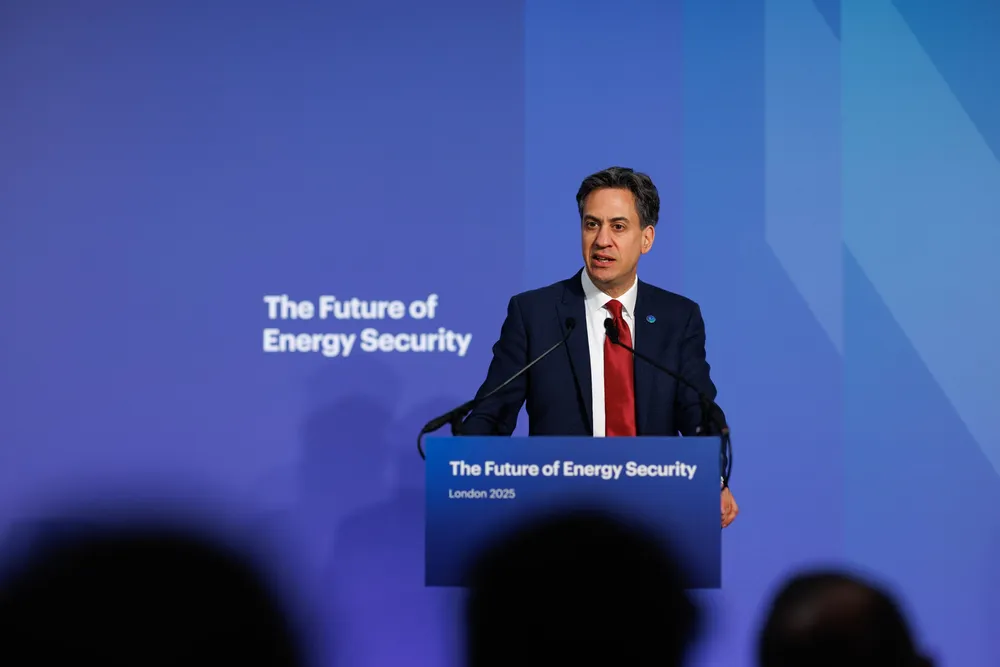Miliband snaps at BP for 'unhelpful, disappointing' offshore wind planning conduct
BP and EnBW ignored direct request from Miliband to assess how wind wakes from their Mona offshore wind project would affect Orsted assets nearby

Energy secretary Ed Miliband has criticised BP and EnBW for their conduct in the planning process for a major UK offshore wind farm, barring them from building it before they submit a wake effects mitigation plan for nearby Orsted assets.
Miliband on Friday granted a development consent for the 1.5GW Mona offshore wind project in the Irish Sea that British oil major BP and German utility EnBW are developing as joint venture partners.
The duo are also developing a twin project, Morgan, over which Miliband is expected to issue a decision on granting development consent next month.
In his decision letter, Miliband criticised BP and EnBW for their “consistent entrenched position” on the issue.
What are wind wakes?
Wind turbines extract kinetic energy from the air to produce electricity. When they do this, they leave trails of slower and more turbulent wind stretching behind them. These trails, known as wind wakes, can stretch vast distances – even 100km. If one wind farm is caught in the ‘shadow’ of another’s wake, the slower wind speed will mean it generates less power. One wind farm ‘waking’ another is sometimes colloquially called ‘wind theft’.
This position was “unhelpful and overly legalistic,” said Miliband, adding he was “unable to agree with any of the arguments” they put forward on this point.
In particular, Miliband said there was “no sensible basis for asserting that an existing windfarm does not amount to ‘existing operational offshore infrastructure’” under the applicable regulations.
There had been much argument about whether Mona could be said to be “close” to Orsted’s various Irish Sea assets, some of which are tens of kilometres away.
Miliband said, rebutting BP and EnBW’s position, that a project is “unarguably ‘close’ enough to be relevant if it is accepted that there is a direct physical impact on that project,” such as through wake effects.
He also criticised BP and EnBW for engaging in a “semantic argument” centring on the definition of the word “licence”.
The lack of an “accepted industry standard model or methodology for carrying out a wake assessment does not mean that an acknowledged impact can simply be ignored,” he said.
Miliband was “particularly disappointed” that BP and EnBW were “expressly asked” to provide a wake assessment but, “instead of complying with that reasonable request, refused to do so for the same legalistic reasons.”
“This is an issue that should and could have been properly addressed during the examination by reasonable parties acting collaboratively, rather than adopting entrenched positions.”
Orsted had warned that wake effects from Mona could cause it to not seek lifetime extensions for its Irish Sea assets, given the hit to their annual energy production and revenues.
But Miliband noted there is an “urgent need” for new offshore wind farms and, even accounting for Orsted’s arguments, the “certain and quantifiable benefits” of the new Mona project “clearly outweigh the indicative and uncertain losses” to the Orsted assets, several of which are not expected to take lifetime extension decisions for at least a decade.
Miliband did insert a requirement in the development consent order that no turbines may be erected at the Mona site until BP and EnBW submit a wake effects plan to him that he approves. This plan must include details of “reasonable steps” taken to reduce wake effects on the Orsted wind farms while also maximising the capacity of Mona itself.
Alternatively, they can agree mitigation directly with Orsted.
While that might seem like a significant win for Orsted, it may result in little. Mitigation of wind wakes, such as by moving around turbines at one wind farm so they have less effect on another, is seen by many as ineffective – and usually does more harm to the site carrying out the mitigation than it benefits the neighbour.
That leaves compensation. Given BP and EnBW have shown no indication whatsoever they would be willing to pay compensation, an agreement with Orsted, which would likely demand this, seems like a non-starter.
Given Miliband is under huge pressure to deliver a successful renewables auction this year and to hit Labour’s ambitious 2030 clean power objectives more generally, it seems doubtful that he would ultimately prioritise the potential lifetime extensions of Orsted projects in a decade’s time over having 1.5GW of fresh capacity he can count on by 2030.
BP and EnBW were contacted for comment
(Copyright)